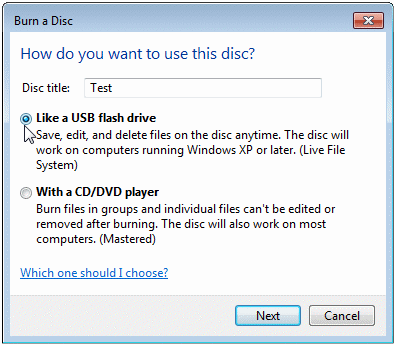In the previous examples, data CDs were burned using the "Mastered" mode. This means the CD was finalized at the end of the burn process and no further data can be added. Windows Vista and later, however, offer the "live file system" for writing data.
The live file system writes data on media in UDF format and enables later modification of CD content. With a physical re-writable CD, new data is added at the end of existing data and the table of contents is updated. Thus the amount of space available on the CD is reduced with each addition of data, and data can be written until no more space is available. When you use this mode with virtual re-writable blanks, the data they contain can be modified at any time, no matter how often the medium is inserted and ejected.
To activate the live file system for a blank medium, the option in the "Burn a Disc" dialog must be set to Like a USB flash drive.

|
Physical media written using the live file system are not fully compatible with all operating systems. |
|
When the live file system is used with a write-once virtual blank, such as a CD-R, the medium is finalized on ejection, and it is not possible to add data later. |
|
Windows XP can read CDs that were written using the live file system, but cannot use the live file system to create CDs. |
|
This section of the manual has presented only certain aspects of the live file system in connection with Virtual CD. For more information on the live file system and its uses, please refer to your operating system documentation. |